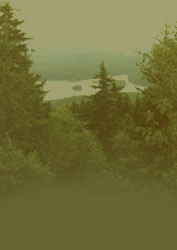|
Do you have something
happening in your corner of Washington? - Please call a member
or e-mail your observations to have them included here
December:
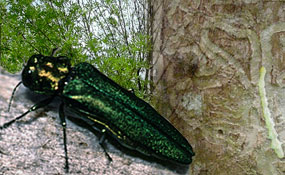
Emerald Ash Borer Picture by US Forest Service
Firewood Quarantine in Hillsboro County!
With the discovery of an invasive beetle infestation Hillsborough became the latest New Hampshire county under a firewood quarantine. The quarantine expansion went into effect last week, after Emerald Ash Borer was discovered in the town of Weare, which makes three counties now in lockdown. This means that firewood can no longer be taken from Hillsborough County and brought elsewhere.
The beetle was first detected in the state in Concord in the spring of 2013, and has since been found in Canterbury, Bow, Loudon, Hopkinton and Salem. Merrimack and Rockingham counties are also under the quarantine.
Generally infested trees are discovered only after a few years, once the insects have multiplied to be point that the trees health is compromised. This makes the spread of the insect especially difficult to stop. In some parts of the Midwest, the Asian beetle has wiped out 99 percent of ash trees in slightly more than a decade of infestation.
Information found at: NHPR - post by Sam-Evans Brown
November:
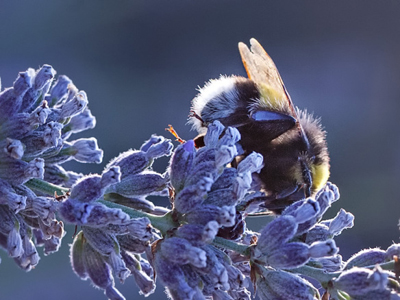
Picture by Beeisbeautiful
This fall, Nan saw lots of sleepy bees resting on the fall asters and mums in the late afternoon or early morning. Honey bees and most bumblebees do return to their hives at the end of the day but males of solitary species can be found sleeping on plant stems, under leaves, and in flowers. You may also see bees that where out to late and didn't get back before dark. At rest a bumblebee's body temperature will fall to that of its surroundings.
Especially in the fall when the nights get cool, bumblebees are almost comatose until the sun warms them up. Honeybees usually don't get caught out at night, they make sure to fly back to the hive.
Bees use the sun to find their way back to the hive and also to the flowers. The bees you find in your flower heads in the morning are just cold and waiting to warm up to go back home. To raise the temperature of their flight muscles high enough to enable flight - the bumblebee will shiver, just the same as we do when we are cold.
October:
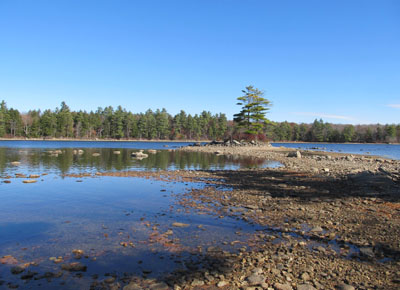
Picture by Wentworth Lake Association
Time for the annual lake drawdown!
Many lakes and ponds in New Hampshire are impounded, meaning they are created and the lake level is controlled by a dam. New Hampshire Department of Environmental Services Dam Bureau begins its annual drawdown on most of the lakes, where it has control on October 8th. Drawdowns are conducted each fall to reduce winter ice damage to shoreline properties and reduce spring flooding. Drawdowns also give property owners an opportunity to conduct any necessary repairs to their waterfront property, provided they first secure a permit from the DES. The larger lakes generally do not reach their full drawdowns until late fall or March in time for ice out and spring runoff.
The length of winter drawdown is based on ice and snow cover, water uses, and expected water renewal rates. It is imperative that the water level be brought down slowly, in order to allow for aquatic fauna to adapt to the changing water levels. It is also important that the lake be brought back to normal full-lake levels before the summer season begins for a variety of reasons, including ecological, recreational, aesthetic, and for keeping terrestrial species from encroaching on the lake bed.
Sometimes a deep drawdown will be done to control aquatic plants in a lake. Low water levels will expose the plants to desiccation (drying) and could ultimately affect plant vascular structure, thereby rendering the plant incapable of nutrient transport and function. This can temporarily reduce plant density for an undetermined period of time.
Fall/winter drawdowns can be beneficial by thorough freezing of the plants and the lake sediments. Freezing of the plants damages the structure and integrity of the vegetative material. Freezing of the lake sediments will impact rooting systems and rhizomes, both by freeze damage, scouring, and subsequent uplifting of the rooting systems. Scouring action of ice moving over the exposed lakebed will force tubers and rooting systems from the substrate.
While being an economical means of plant control, lake drawdown is also rather unpredictable, and may cause some species to actually increase in abundance, or not affect some target species at all. Further, draining the water from an aquatic system can be detrimental to non-target organisms.
Algal or cyanobacteria blooms may follow a drawdown. Changes in the bottom sediment may also occur as a result of drawdown. Aquatic food web changes may result in shifts in plant and animal structure due to drawdown. Oxygen concentrations throughout the water column may be impacted by the drawdown. Impacts and even mortality to aquatic animal species is a big risk during drawdown. Many organisms that make their home in the aquatic environment,including fish, frogs, salamanders, turtles, aquatic insect larvae, mussels, and others can all feel the impacts of drawdown. Agile and faster moving organisms (like fish) may be able to move upstream or downstream to other unimpacted habitats; still, these fish may be confined to smaller, shallower areas where they become easy prey to consumers or suffer from oxygen deprivation. Finally, there may also be a long-term change in plant species composition from “drawdown-susceptible” plants to “drawdown-resistant” plants.
Hopefully the deep drawdowns on our lakes in Washington will have desirable outcomes and not compromise the health of the lakes even in the short term.
Information found at: NH DES
September:
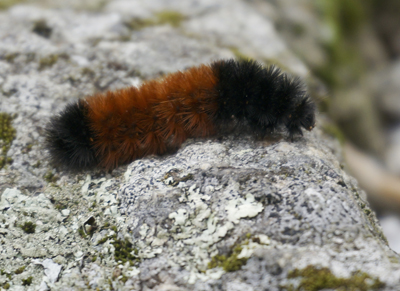 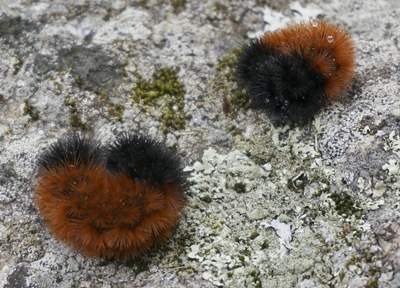
Woolly Bear picture by Jed Schwartz
Woolly Bears playing defense
While picking up trash recently on the Conservation Commission's "Adopt a Highway" route, Jed and Nan observed many "Woolly Bears" on the move. Some had a wide brown stripe in the middle and some had a narrow one. They wondered what this meant for the impending winter because according to a popular tale, Woolly Bears can predict the severity of the winter to come.
The Woolly Bear is the caterpillar stage of the Isabella Tiger Moth and it is found in many cold regions, including the Arctic. It emerges from its egg in the fall and overwinters in its caterpillar form by freezing solid. It survives being frozen by producing a cryoprotectant (antifreeze) in its tissues. In the spring it thaws out and emerges to pupate. Once it emerges from its pupa as a moth it has only days to find a mate.

Isabella Tiger Moth - Steve Jurvetson - Wikipedia
In most temperate climates, caterpillars become moths within months of hatching, but in the Arctic the summer period for vegetative growth – and hence feeding – is so short that the Woolly Bear must feed for several summers, freezing again each winter before finally pupating. Some are known to live through as many as 14 winters.
The Woolly Bear is covered in short bristles called setae. Its main defense when picked up or disturbed is to roll into a ball.
It feeds on many different species of plants, especially herbs and flowering plants.
Folklore of the eastern United States and Canada holds that the relative amounts of brown and black on the skin of a Woolly Bear caterpillar (commonly abundant in the fall) are an indication of the severity of the coming winter. It is believed that if a Woolly Bear caterpillar's brown stripe is thick, the winter weather will be mild and if the brown stripe is narrow, the winter will be severe. In reality, hatchlings from the same clutch of eggs can display considerable variation in their color distribution, and the brown band tends to grow with age; if there is any truth to the tale, it is highly speculative.
Information found at: Wikipedia
August:
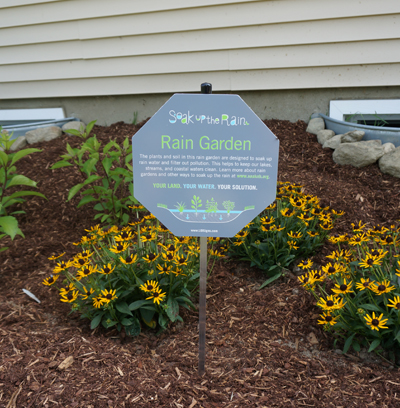
Our “Soak Up the Rain” presentation and project took place on August 8th at Camp Morgan Lodge. We didn’t get a big crowd but it was a very successful presentation and project installation.
Jill McCarthy and Lisa Loosigian, from NH Department of Environmental Services, presented an educational talk about stormwater runoff and it’s effects on our lakes and ponds, and showed us many simple projects that home owners can do to mitigate the problem around their homes.
Afterward, we went outside to tackle a rain garden installation project on the lakeside of Camp Morgan Lodge. Eric Williams and Rob Livingston from NH DES were there to help too, Rob installed a gutter and downspouts and both he and Eric supplied lots of muscle power throughout the day.
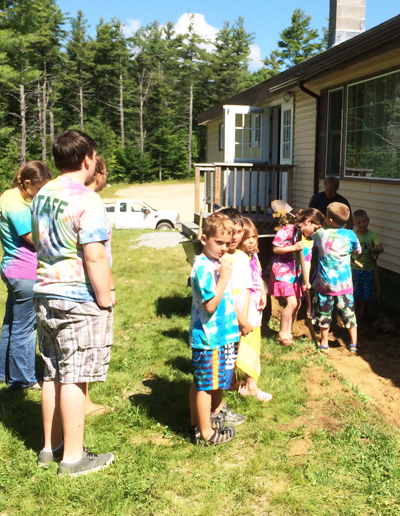
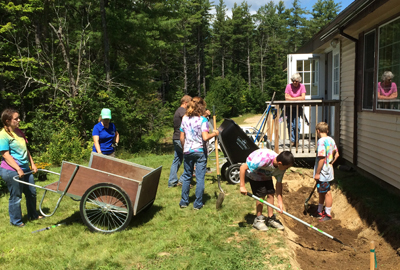
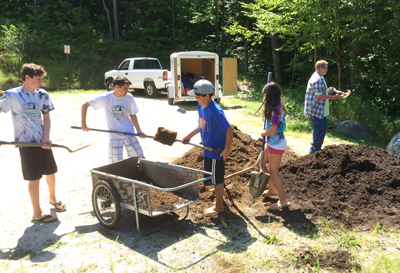
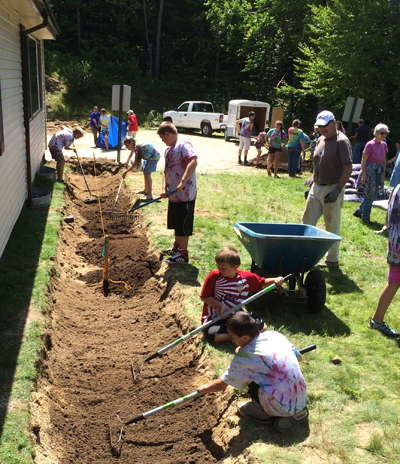
The Camp Morgan kids. joined us in groups to help with the digging, earth moving and soil amending and got a lesson about stormwater runoff, too. We thank Director Yvonne Bachand and the camp staff at Camp Morgan for helping us out and letting the kids participate! We thank Steve and Diana Hanssen for sticking around through all the hard labor to get to the “fun part” – planting the plants!
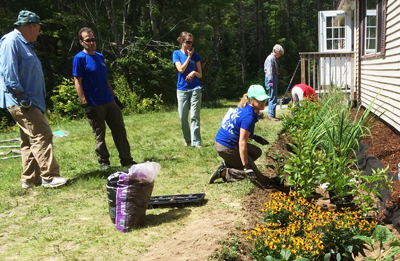
We thank all the folks from NH DES’s “Soak Up the Rain” program for coming to Washington, supplying all the plants, garden design, know-how and effort to make this project happen. The rain garden project came out beautifully and it held up perfectly during our 5½ inch rain event last week. Please go up to the Lodge and check it out!
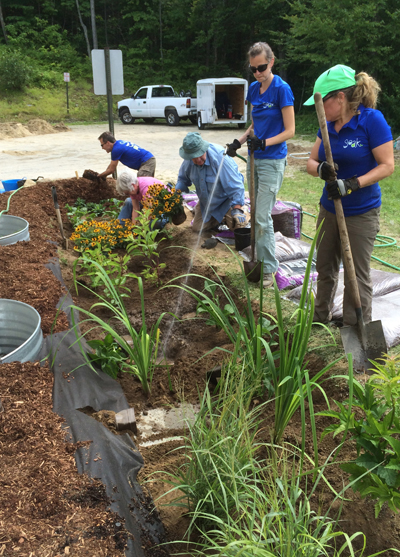
If you are thinking about dealing with a runoff problem around your home contact us for some information and how-to ideas. It’s not just about rain gardens, there are many other ways to deal with your stormwater. Visit the "Soak Up the Rain" website for lots of helpful information: SoakNH.org. We have a few copies of the New Hampshire Homeowner’s Guide to Stormwater Management, these are available, to borrow, at the Town Hall, (or click on the name to take a look at it online).
If you find a project you want to do, we might even be able to pull a gang together to help you get it done.
July:
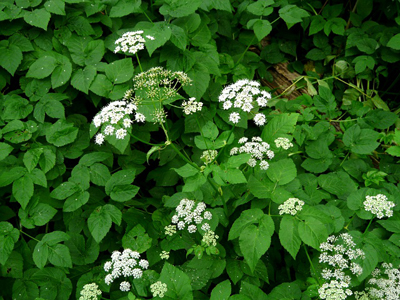
Goutweed
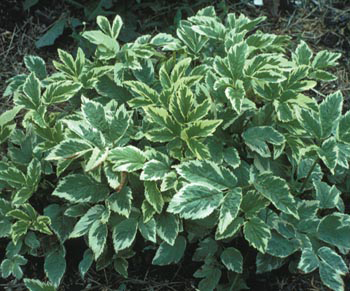
Varigated Goutweed
Do you have this invasive in your garden?
Goutweed is an aggressive invasive plant that forms dense patches, displaces native species, and greatly reduces species diversity in the ground layer. Goutweed patches inhibit the establishment of conifers and other native tree species as well.
It is found in old gardens and flowerbeds, around shrubs and other plantings, and in a variety of other disturbed habitats such as felled forests, abandoned fields, and pastures.
Goutweed, also known as bishop's-weed, ground elder and snow-on-the-mountain, is an herbaceous perennial plant in the carrot family. It was brought to North America as an ornamental from Europe and Asia. It is a prolific ground cover that can quickly take over the garden. It spreads rapidly under favorable growing conditions and because of this it has been described as a nuisance species, and been labeled one of the "worst" garden weeds in perennial flower gardens.
Most leaves are basal, with the leafstalk attached to an underground stem, or rhizome. The leaflets are toothed and sometimes irregularly lobed. Foliage of the "wild" type is medium green in color; a commonly planted variegated form has bluish-green leaves with creamy white edges. Sometimes reversion back to solid green or a mixture of solid green and the lighter variegated pattern occurs within a patch.
Small, white, five-petaled flowers are produced in mid-summer. Flowers are arranged in flat-topped clusters (called compound umbels) and are held above the ground on a leafy stem up to about 3 feet tall.
MANAGEMENT OPTIONS
A variety of methods are available for controlling goutweed, depending on the extent of the infestation and the amount of time and labor available. Regardless of the control method used, the patch should be carefully monitored periodically for a few years. New shoots should be dug up and destroyed. Once goutweed control has been achieved, revegetation with native or non-invasive exotic plant materials is recommended. This is particularly important on sites where erosion is a concern or where other invasive species are likely to colonize the site if left alone.
Manual
Small patches of goutweed can be eliminated by careful and persistent hand-pulling or digging up of entire plants along with underground stems (rhizomes). Pulled plants can be piled up and allowed to dry for a few days before bagging and disposing of them. Be careful to pick up all rhizomes which, if left behind, can reroot and sprout new plants. For large patches, a team of volunteers or use of herbicide is recommended.
Mechanical
Where appropriate, frequent short mowing may control or slow the spread of goutweed in lawns, along roadsides, and other areas.
If you have this agressive invasive in your garden you'll have to work diligently to get rid of it!
Information found at: National Parks Service - Plant Conservation Alliance, Bureau of Land Management
June:
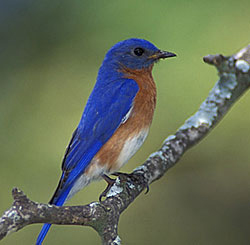
Bluebird male - New Hampshire Birds
Eastern Bluebird
Of all the birds a gardener could choose to attract, the bluebird is the quintessential helpful garden bird. Gardeners go to extreme lengths to attract and keep them in the garden for their advantageous properties. Bluebirds are voracious insect consumers, quickly ridding a garden of insect pests.
About two-thirds of the diet of an adult consists of insects and other invertebrates. Favored insect foods include grasshoppers, crickets, katydids, and beetles. Other food items include earthworms, spiders, millipedes, centipedes, sow bugs, and snails. The remainder of the bird's diet is made up of wild fruits or berries. Fruits are especially important when insects are scarce in the winter.
The bright-blue breeding plumage of the male, easily observed on a wire or open perch, makes this species a favorite of birders. The male's call includes sometimes soft warbles of 'jeew' or 'chir-wi' or the melodious song 'chiti WEEW wewidoo'
Bluebirds are territorial and prefer open grassland with scattered trees. This is similar to the behavior of many species of woodpecker. Eastern Bluebirds tend to live in open country around trees, but with little understory and sparse ground cover. Original habitats probably included open, frequently burned pine savannas, beaver ponds, mature but open woods, and forest openings. Today, they’re most common along pastures, agricultural fields, suburban parks, backyards, and even golf courses.
Bluebirds can typically produce between two and four broods during the spring and summer (March through August in the northeast). Males identify potential nest sites and try to attract prospective female mates to those nesting sites with special behaviors that include singing and flapping wings, and then placing some material in a nesting box or cavity. If the female accepts the male and the nesting site, she alone builds the nest and incubates the eggs.
Predators of young bluebirds in the nests can include snakes, cats and raccoons. Non-native and native bird species competing with bluebirds for nesting locations include the Common Starling, American Crow, and House Sparrow, which take over the nesting sites of bluebirds, killing young and smashing eggs and probably killing adult bluebirds.
Attract some Bluebirds to your yard by providing nest boxes and benefit by their insectivorous diet and beautiful trilling, warbling serenades. What you need to know about Bluebird Nest boxes here:
Nest Box Basics
A simple plan for a nest box can be found here:
Nest Box Plan
Information found at: Wikipedia - Bluebirds and
Wikipedia - Eastern Bluebirds
May:
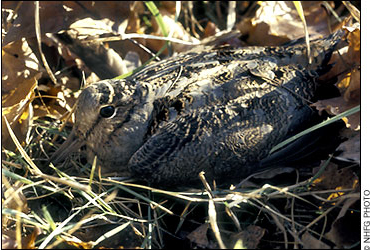
Woodcock male
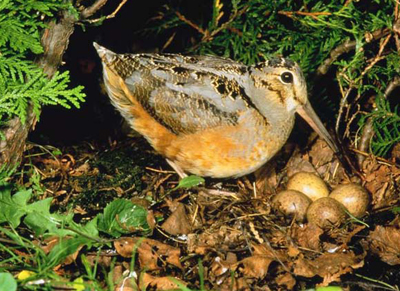
Woodcock female
The American Woodcock
This month Arin heard a Woodcock near the Elementary School at dusk. The American woodcock is also known as the timberdoodle and the night partridge. In the wild, the American woodcock has a life span of up to eight years. It is a solitary bird and is most active after dusk.
With mottled brown feathers, the woodcock is nearly invisible as it sits fight among the dry leaves of the forest floor. Short, rounded wings enable it to fly through dense, shrubby cover. Large eyes set far back on the head provide a wide viewing angle. Its long prehensile bill has a flexible tip which aides in grabbing food while probing through moist soil. Though earthworms make up 50 to 90% of the diet, larvae of beetles, flies, and other insects are consumed when available. Ants, moths, snails, and seeds from various plants are occasionally taken.
The male weighs approximately 5.3 ounces while the larger female averages 7.0 ounces.
Woodcock arrive back in New Hampshire from mid-March to mid-April and make their southward fall migration in October to Southern New Jersey and the Ohio Valley to Florida and Texas.
Woodcock perform a unique courtship display at dawn and dusk upon arrival on the "singing grounds" in spring. To court females, the male flies upward in fight, spiraling circles creating a twittering sound with its outer primary wing feathers. At the height of its flight, the male flies steeply downward, landing close to its original position. After each flight the male emits a series of nasal "peents." Males repeat this performance 10 to 20 times during an evening.
Woodcock spend nights roosting in fields. At dawn they return to nearby feeding areas. Nests are usually located within 300 feet of the singing grounds in young hardwood stands. Four eggs, laid in a shallow depression in the leaf litter, hatch in 19 to 22 days. Young woodcock are precocial, hatched completely feathered with eyes open, ready to run at any sign of danger.
Woodcock are adapted to wooded environments and require four different habitat types. Clearings are used by males for courtship display. Moist, fertile soils with alder or dense second growth hardwood offer feeding areas. Young, second growth hardwood stands provide nesting and brood rearing habitat. Large fields are needed as night roosting sites. It's important to have all four habitat elements in close proximity.
Next time you are outside near dusk this time of year, listen for the Woodcock's mating call, you might get to see his spectacular flight while he tries to woo a mate.
Article found at: NH Fish and Game
Pic and info:
April:
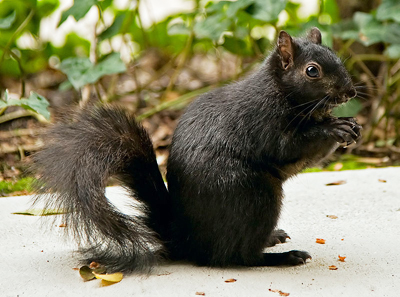
Black squirrel picture
The Black Squirrel
Arin spotted a black squirrel near Chase Farm on Route 31!
What appears to be a different species of squirrel is actually a genetic mutation of the Eastern Gray Squirrel (melanism). The mutation causes the melanin within the squirrel to produce an excess of the chemical that causes darker pigmentation.They are common in the Midwestern United States, Ontario, Quebec, parts of the Northeastern United States and Britain.
As a melanistic variety of the eastern grey squirrel, individual black squirrels can exist wherever grey squirrels live. Grey mating pairs cannot produce black offspring. Grey squirrels have 2 copies of a normal pigment gene and black squirrels have either 1 or 2 copies of a mutant pigment gene. If a black squirrel has 2 copies of the mutant gene it will be jet black. If it has 1 copy of a mutant gene and 1 normal gene it will be brown-black.
In areas with high concentrations of black squirrels, mixed litters are common. The black subgroup seems to have been predominant throughout North America prior to the arrival of Europeans in the 16th century, since their dark color helped them hide in old growth forests which tended to be very dense and shaded. As time passed, hunting and deforestation led to biological advantages for grey colored individuals.
Today, the black subgroup is particularly abundant in the northern part of the eastern grey squirrel's range. This is likely due to the significantly increased cold tolerance of black squirrels which lose less heat than greys. Black squirrels also enjoy concealment advantages in denser northern forests. There are several notable introduced populations of black squirrels.
Though black squirrels are common or predominant in many areas of North America, their overall rarity (perhaps as few as 1 in 10,000) has caused many towns, cities, colleges, and universities to take special pride in their populations of black squirrels. Several cities and towns in the United States and one in Canada make efforts to publicly promote their local populations of black squirrels. The large black squirrel population in Kent, Ohio, has led it to become a mascot at Kent State University, which holds a Black Squirrel Festival in September each year to honor the growing colony there.
Next time you drive Route 31 take a glance around and see if you spot the black squirrel!
Article found at: Wikipedia
March:
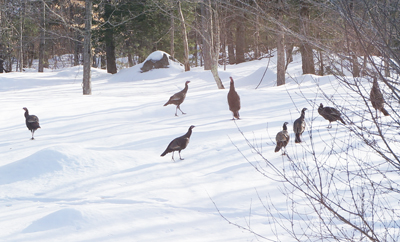
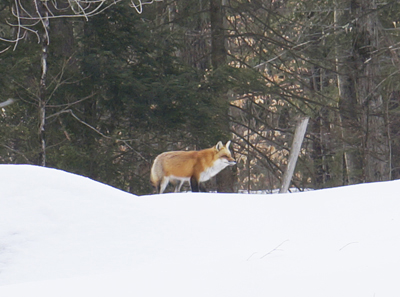
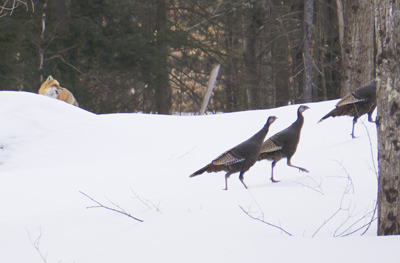
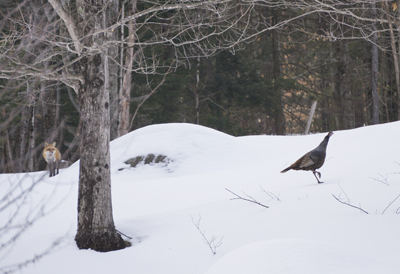
Pictures by Jed Schwartz
Jed's Wild Kingdom
Last Sunday while looking out the window Jed spied a large flock of wild turkeys coming out of the woods and walking in a line through his open field. We have seen a lot of turkey flocks this winter and they are fun to watch as they make their way through the yard in search of a meal. They travel in big numbers and are comical to observe.
This flock headed straight for the bird feeder near the house and busily ate whatever seeds they could find, left scattered on the ground by the marauding squirrels. They finished up their snacks and headed back across the street to the field where they walked around some more eating snow bugs and other treats they happened to find.
Suddenly out of the woods walked a large Red Fox who quickly spied the turkeys wandering around. He quietly made his way closer to the birds thinking this might be his lucky day; a big meal for little work. He made a few quick dashes at the turkeys now sprinkled across the field. Some flew up in the trees and others sprinted out of reach.
The hungry Red Fox tried hiding behind a large boulder but the turkeys were on to him. At one point they even surrounded him as if they were mocking his useless attempts to grab one of them. He was like a bright red beacon against the white field of snow.
After fifteen minutes or so of futile hunting, poor Mr. Fox gave up and ran back into the woods. The turkeys flocked back together and strolled off on their way. There was no happy meal for Mr. Fox that day.
January:
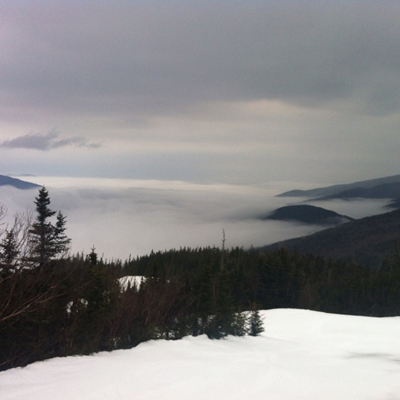
Wildcat Mountain by Eric Slason
Temperature Inversion
Tom commented on the recent temperature inversion that caused heavy fog and vastly different conditions at different altitudes.
Temperature inversion layers, also called thermal inversions or just inversion layers, are areas where the normal decrease in air temperature with increasing altitude is reversed and air above the ground is warmer than the air below it.
Inversion layers are significant to meteorology because they block atmospheric flow, which causes the air over an area experiencing an inversion to become stable. This can then result in various types of weather patterns.
Temperature inversions are a result of other weather conditions in an area. They occur most often when a warm, less dense air mass moves over a dense, cold air mass. This can happen for example, when the air near the ground rapidly loses its heat on a clear night. In this situation, the ground becomes cooled quickly while the air above it retains the heat the ground was holding during the day.
Topography can also play a role in creating a temperature inversion since it can sometimes cause cold air to flow from mountain peaks down into valleys. This cold air then pushes under the warmer air rising from the valley, creating the inversion. In addition, inversions can also form in areas with significant snow cover because the snow at ground level is cold and its white color reflects almost all heat coming in. Thus, the air above the snow is often warmer because it holds the reflected energy.
Some of the most significant consequences of temperature inversions are the extreme weather conditions they can sometimes create. One example of these is freezing rain. This phenomenon develops with a temperature inversion in a cold area because snow melts as it moves through the warm inversion layer. The precipitation then continues to fall and passes through the cold layer of air near the ground. When it moves through this final cold air mass it becomes "super-cooled" (cooled below freezing without becoming solid). The super-cooled drops then become ice when they land on items like cars and trees and the result is freezing rain or an ice storm.
Intense thunderstorms and tornadoes are also associated with inversions because of the intense energy that is released after an inversion blocks an area’s normal convection patterns.
Although freezing rain, thunderstorms, and tornadoes are significant weather events, one of the most important things impacted by an inversion layer is smog. This is the brownish gray haze that covers many of the world’s largest cities and is a result of dust, auto exhaust, and industrial manufacturing.
Smog is impacted by the inversion layer because it is in essence, capped, when the warm air mass moves over an area. This happens because the warmer air layer sits over a city and prevents the normal mixing of cooler, denser air. The air instead becomes still and over time the lack of mixing causes pollutants to become trapped under the inversion, developing significant amounts of smog.
Article found at: About.com
To view yearly archives of our "New In
Nature" series click on year you wish to see.
2002
2003
2004
2005
2006
2007
2008
2009
2010
2011
2012
2013
|


